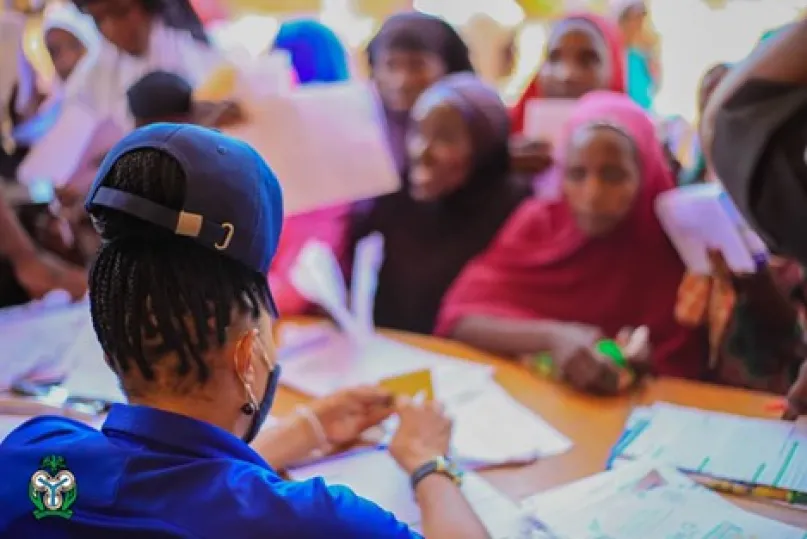Blazing a Trail for Women’s Financial Inclusion in Nigeria

The Strategy outlined high expectations to reach 80 percent of adults in the country with formally regulated financial services through a series of coordinated interventions. Progress towards this target has advanced steadily (the financial inclusion rate was 64 percent as of 2020, up from 53.7 percent in 2012) and the goal has since been revised to 95 percent by 2024.
Shifting the focus to women
While financial inclusion has seen a slow and steady improvement, persistent gaps linger, especially among certain demographics. In 2018, a survey conducted by Enhancing Financial Innovation and Access (EFInA) revealed that 41 percent of adult women had no access to any formal financial products (i.e. payments, savings, credit, insurance or pensions), compared to 33 percent of men, putting the financial inclusion gender gap at eight percentage points. When you look only at savings, payments and credit, the gap is even wider: 33 percent of women had access to these banking products compared to 46 percent of men.
In 2019, following Nigeria’s commitment to the Alliance for Financial Inclusion Denarau Action Plan – which calls on member countries to be intentional in addressing gender gaps in access to finance, a Financial Inclusion Gender Desk was set up within the Development Finance Department of the Central Bank of Nigeria.
That same year, we conducted a study in partnership with EFInA to assess the state of women’s financial inclusion in the country and identify the obstacles we needed to overcome in order to continue progress towards the country’s ambitious financial inclusion goals. We found that women’s lower education and income levels, as well as a history of lack of trust in financial service providers, were key barriers to women’s financial inclusion in Nigeria. Now what we needed was a plan to address these barriers.
Eight strategic imperatives for addressing women’s financial inclusion
In 2020, we launched the Framework for Advancing Women’s Financial Inclusion in Nigeria to provide what had been lacking – an intentional roadmap to address the plight of vulnerable, financially excluded women. :
- Measures to support increased account opening by women.
- Financial and digital literacy for women.
- Expansion and use of non-traditional channels to reach women customers closer to home.
- Development of systems for gender-disaggregated data collection.
- Enabling environment required to advance the government’s financial inclusion agenda.
- Development of financially sustainable products and delivery systems that respond to low-income women’s needs.
- Digital financial inclusion and fintech solutions to improve women’s inclusion.
- Women’s leadership and staffing across financial institutions and other key agencies.

To implement these imperatives, eight Communities of Practice (COPs) have been established which meet quarterly to work on agreed initiatives and monitor progress against set targets. Among the actions taken so far, the COPs have:
- Organized dedicated account opening drives focused on taking products and services closer to women in rural communities.
- Supported the development of a strategy to leverage agent networks to drive women’s financial inclusion.
- Contributed to the development of a Women’s Financial Inclusion dashboard which will provide financial services providers and policymakers with real-time data on indicators to measure access to finance for women.
Acting in unity to close the gender gap
As I was writing this, a colleague of mine asked me what I was most excited about as we journey towards achieving equal financial access for both women and men. My response was simple: I’m excited about the opportunities that are opening up. More and more, funds are being dedicated to improving gender equality (for example, development finance policies of the Central Bank of Nigeria ensure that women are a priority segment when establishing schemes and interventions). High-ranking government officials and policymakers are increasingly setting aside time to work on solutions for women’s financial inclusion.
On the supply side, financial service providers are building their capabilities to deploy tailored solutions. Knowledge is being exchanged among peers to tackle the problems that still exist.
Are these efforts sufficient to close the challenging gender gaps in financial inclusion in Nigeria? Only time will tell. With effective coordination between our eight communities of practice, we hope to be sharing great stories in the coming years.



This article has ignited a need to get such informed exposures for many women who have great ideas of a cut across benefit to both gender. How can one get in touch with Ms Abu of CBN ?
Leave a comment